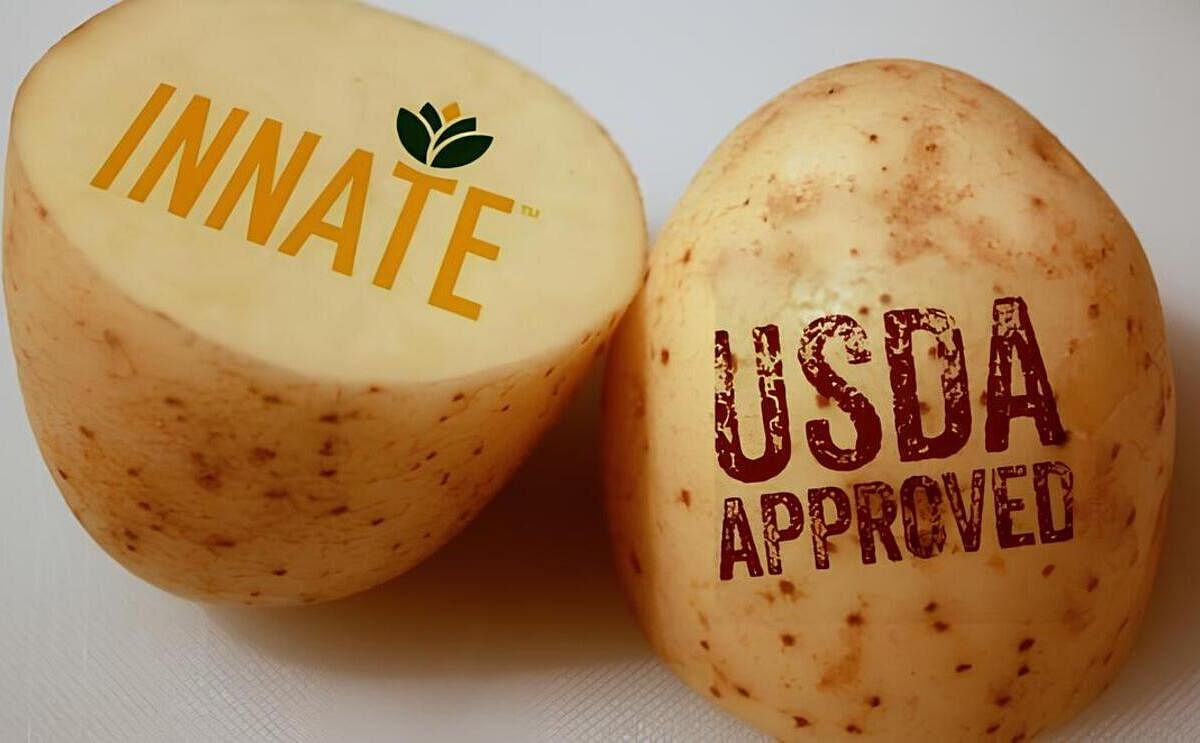A look at the Innate Potato by FrankenFoodFacts
A look at the Innate Potato by FrankenFoodFacts

The blog FrankenFoodFacts recently published a review of the Innate potato of Simplot Plant Sciences.
This blog by Layla Katiraee (@BioChicaGMO), who holds a Ph.D. in molecular genetics from the University of Toronto and is a senior scientist in product development at a biotech company in California. offers the most insightful review of the Innate Potato PotatoPro has seen so far.
The Innate Potato
The Innate Potato is a GMO that was recently approved for cultivation in the US. It is made by Simplot (or J.R Simplot Company). According to their website, they are a “food and agribusiness empire”. They do everything from seeds and fertilizer, to frozen foods. Apparently, they made billions by “commercializing frozen french fries“, and later became one of McDonald’s major suppliers. So I think it’s safe to say that they know their spuds.
The Innate Potato uses RNAi to silence 4 different proteins. RNAi is the same methodology that is used to make the non-browning Arctic Apple. Here’s the entry for RNAi from Wikipedia (it’s actually a pretty decent overview), but very briefly, RNAi or RNA interference is a naturally occurring process in cells that can turn off or silence specific RNA molecules, and consequently, the proteins that they make. In the past few decades, scientists have harnessed RNAi to turn off genes that they’re studying. If you add a properly-designed sequence of DNA corresponding to the gene you’re interested in silencing, it will produce an RNA molecule that will trigger RNAi and then, wham!!! The protein gets shut-down.
In the context of our discussion on the Innate Potato, it’s important to note that a protein from a different organism has not been added. It’s not like the mythical “fish genes in a tomato”. The DNA sequence that has been added is from the potato itself, which is why they’ve called it the “Innate Potato”. Thus, this isn’t a transgenic crop, where the gene added is from a species distant to the potato. It is a cisgenic crop, where the genes came from closely related species; in this case, either from the potato itself or from a wild potato native to Mexico (Solanum verrucosum).
So what proteins are silenced in the Innate Potato and why? Four different proteins are silenced and these are involved in three different traits:
The Papers
In the first paper (which is freely available via the company’s website), the authors attempt to silence 2 genes that synthesize the amino acid asparagine. They had success in greenhouse trials, but to their surprise, the field trials failed: the potatoes were really small and “cracked” (the picture in the paper is worth looking at. The taters definitely look wonky). However, the controls grew fine suggesting that it wasn’t something environmental: it was the silencing of the two genes that caused these problems. They went on to do a series of experiments where they silenced the 2 genes individually. They got potatoes with quality equivalent to controls but with reduced asparagine levels by silencing just one of the genes just in the tubers/potatoes (scientists can often control what part of the plant they want to turn a gene off/on in). They managed to reduce amounts of asparagine by 60-80%.
The second paper was behind a paywall (I forgive Simplot for not publishing in an open access journal only because the paper was accepted in 2006, before open access was a popular “thing”). The paper starts by outlining that the Russet Burbank strain of potato is more pest resistant, but is seldom used because it has issues with discoloration and sensitivity to bruising. Additionally, it accumulates high levels of sugar in cold storage which, not only result in higher levels of acrylamide, but also makes french fries less golden. The paper set out to address these issues by a) reducing the levels of the enzyme that causes bruising (explained in the previous section), and b) reducing the amounts of two enzymes associated with starch formation so that fried potatoes have a more appealing hue and have less acrylamide.
As a side note, this sentence in the Materials and Methods was somewhat hilarious: “Sensory evaluations of French fries were performed by a panel of eight professionally trained experts at the optimum time of 3 min out of the fryer.” Who is a professionally trained expert on French fries sensory evaluation? More importantly, how can I get that job??
The authors did a series of tests to confirm that the potatoes grown in the field actually had the physical traits they wanted. For example, when testing for bruising, they “physically impacted” the potatoes and after 2 weeks, fries were made out of them to see if they blackened (I’d LOVE to be the grad student on that project… You’d spend your time throwing around potatoes, all in the name of science :) ). They show that the modified potatoes have less acrylamide formed, and they have lots of pictures of French fries showing that the modified potatoes have more of a golden-hue to them. They also performed a few experiments showing that the modified potatoes kept their “agronomic performance”: when compared to controls, they weren’t more susceptible to blight, they were of the same size, and had more starch content. All in all, the paper’s findings suggest that silencing of the 3 genes didn’t have a negative impact and had all the desired traits.
Conclusions
So I couldn’t find any papers that convincingly indicated that there’s enough acrylamide in fried potatoes to be a huge concern. Additionally, no reputable organization states that acrylamide in food causes cancer in humans (here’s info from the National Cancer Institute on the topic). In fact, a few studies that have examined the incidence of cancer and dietary acrylamide have failed to find any association (see here and here, and a recent meta-analysis here). Keep in mind that we eat natural toxins everyday, but not in amounts that are of concern. However, dietary acrylamide is enough of a concern to some people that all places that serve french fries in California have the ubiquitous (and therefore useless) warning stating that the location has food known to the state of California to cause cancer or birth defects (i.e. Prop 65). So it seems that this could be a potato of interest to the general public and the food industry.
Many of the usual arguments against GMOs don’t hold for the Innate Potato. Here’s why I think that the Innate Potato has less GMOiness (and by “GMOiness” I mean that subjective, intangible thing that makes people protest the introduction of any GMO into the market):
I’m also very curious to see how they’re going to handle the labeling of the potato. The potato is designed to be nutritionally different from other potatoes, so it is not substantially equivalent. As you may know, the reason why genetically modified ingredients are not labeled in the United States is because they are nutritionally equivalent to their non-genetically modified counterparts. So technically, the Innate potato should be labeled.
Will they just list “Innate Potato” as an ingredient?
It’ll be interesting to see how this plays out.
This blog by Layla Katiraee (@BioChicaGMO), who holds a Ph.D. in molecular genetics from the University of Toronto and is a senior scientist in product development at a biotech company in California. offers the most insightful review of the Innate Potato PotatoPro has seen so far.
The Innate Potato
The Innate Potato is a GMO that was recently approved for cultivation in the US. It is made by Simplot (or J.R Simplot Company). According to their website, they are a “food and agribusiness empire”. They do everything from seeds and fertilizer, to frozen foods. Apparently, they made billions by “commercializing frozen french fries“, and later became one of McDonald’s major suppliers. So I think it’s safe to say that they know their spuds.
The Innate Potato uses RNAi to silence 4 different proteins. RNAi is the same methodology that is used to make the non-browning Arctic Apple. Here’s the entry for RNAi from Wikipedia (it’s actually a pretty decent overview), but very briefly, RNAi or RNA interference is a naturally occurring process in cells that can turn off or silence specific RNA molecules, and consequently, the proteins that they make. In the past few decades, scientists have harnessed RNAi to turn off genes that they’re studying. If you add a properly-designed sequence of DNA corresponding to the gene you’re interested in silencing, it will produce an RNA molecule that will trigger RNAi and then, wham!!! The protein gets shut-down.
In the context of our discussion on the Innate Potato, it’s important to note that a protein from a different organism has not been added. It’s not like the mythical “fish genes in a tomato”. The DNA sequence that has been added is from the potato itself, which is why they’ve called it the “Innate Potato”. Thus, this isn’t a transgenic crop, where the gene added is from a species distant to the potato. It is a cisgenic crop, where the genes came from closely related species; in this case, either from the potato itself or from a wild potato native to Mexico (Solanum verrucosum).
So what proteins are silenced in the Innate Potato and why? Four different proteins are silenced and these are involved in three different traits:
- The first trait is prevention of potato bruising (again, this is very similar to the non-browning Arctic Apple).
Potato bruising is caused when damaged cells release an enzyme known as polyphenol oxidase (PPO) which interacts with different compounds creating the black or dark grey color. In the Innate Potato, the PPO enzyme is “turned off” only in the tuber and remains on in the leaves.
Currently, many steps are taken in potato farming and handling to prevent bruising, but it doesn’t seem to be enough. Potato bruising costs the industry “at least $298 million annually”. Keep in mind that those bruised potatoes don’t make their way to the store, so that translates to a lot of food waste, too.
The company claims that the potatoes will not turn brown for several days, compared to just 10 minutes with a normal potato. - The second trait is reduction in the amount of acrylamide produced in the potato.
Acrylamide is a chemical compound which is also a known carcinogen at high doses. We use it in the lab fairly frequently. When I started doing lab work, I had the annoying task of making our acrylamide solutions, since I was the lowly undergrad… Fear not, spouse! I took heavy precautions: a full mask, a full lab coat, etc. Once I got into my PhD, our lab had more funding, so we’d buy the acrylamide solutions pre-disolved. Now that I’m in industry, we buy our acrylamide lab items ready-to-use. Such is the nuisance of acrylamide that no-one wants to deal with it.
So what’s acrylamide doing in potatoes? When potatoes are heated, a chemical reaction (known as the Maillard reaction) occurs between the amino acid asparagine and sugars (such as the naturally occurring sugars in the potato). When I was discussing this article with the spouse, he knew all about the Maillard reaction because it’s what causes browning in food such as meats or bread, and is not to be confused with caramelizing. He had read about it when doing research on how to cook the perfect steak (He’s Texan… It’s the only explanation I have). At high temperatures, such as when potatoes are put in a fryer, acrylamide also forms in the reaction. In the Innate potato, the amount of the enzyme that synthesizes asparagine has been reduced, so consequently, less acrylamide is made. The company’s website claims that the Innate potato produces up to 70% less acrylamide than other potatoes cooked at the same temperature. - The final trait is improvement in starch quality and potato color.
I had a tough time finding a decent description of this trait and relied on information from a Q&A with one of Simplot’s VPs over on Biofortified. Basically, they’ve reduced the amount of sugar in the potato, which can result in “consistent golden color”. Their website and the Q&A say “under certain conditions”, but do not explain what those conditions are so I’m a bit skeptical. I wish there was more information about this trait.
The Papers
In the first paper (which is freely available via the company’s website), the authors attempt to silence 2 genes that synthesize the amino acid asparagine. They had success in greenhouse trials, but to their surprise, the field trials failed: the potatoes were really small and “cracked” (the picture in the paper is worth looking at. The taters definitely look wonky). However, the controls grew fine suggesting that it wasn’t something environmental: it was the silencing of the two genes that caused these problems. They went on to do a series of experiments where they silenced the 2 genes individually. They got potatoes with quality equivalent to controls but with reduced asparagine levels by silencing just one of the genes just in the tubers/potatoes (scientists can often control what part of the plant they want to turn a gene off/on in). They managed to reduce amounts of asparagine by 60-80%.
The second paper was behind a paywall (I forgive Simplot for not publishing in an open access journal only because the paper was accepted in 2006, before open access was a popular “thing”). The paper starts by outlining that the Russet Burbank strain of potato is more pest resistant, but is seldom used because it has issues with discoloration and sensitivity to bruising. Additionally, it accumulates high levels of sugar in cold storage which, not only result in higher levels of acrylamide, but also makes french fries less golden. The paper set out to address these issues by a) reducing the levels of the enzyme that causes bruising (explained in the previous section), and b) reducing the amounts of two enzymes associated with starch formation so that fried potatoes have a more appealing hue and have less acrylamide.
As a side note, this sentence in the Materials and Methods was somewhat hilarious: “Sensory evaluations of French fries were performed by a panel of eight professionally trained experts at the optimum time of 3 min out of the fryer.” Who is a professionally trained expert on French fries sensory evaluation? More importantly, how can I get that job??
The authors did a series of tests to confirm that the potatoes grown in the field actually had the physical traits they wanted. For example, when testing for bruising, they “physically impacted” the potatoes and after 2 weeks, fries were made out of them to see if they blackened (I’d LOVE to be the grad student on that project… You’d spend your time throwing around potatoes, all in the name of science :) ). They show that the modified potatoes have less acrylamide formed, and they have lots of pictures of French fries showing that the modified potatoes have more of a golden-hue to them. They also performed a few experiments showing that the modified potatoes kept their “agronomic performance”: when compared to controls, they weren’t more susceptible to blight, they were of the same size, and had more starch content. All in all, the paper’s findings suggest that silencing of the 3 genes didn’t have a negative impact and had all the desired traits.
Conclusions
So I couldn’t find any papers that convincingly indicated that there’s enough acrylamide in fried potatoes to be a huge concern. Additionally, no reputable organization states that acrylamide in food causes cancer in humans (here’s info from the National Cancer Institute on the topic). In fact, a few studies that have examined the incidence of cancer and dietary acrylamide have failed to find any association (see here and here, and a recent meta-analysis here). Keep in mind that we eat natural toxins everyday, but not in amounts that are of concern. However, dietary acrylamide is enough of a concern to some people that all places that serve french fries in California have the ubiquitous (and therefore useless) warning stating that the location has food known to the state of California to cause cancer or birth defects (i.e. Prop 65). So it seems that this could be a potato of interest to the general public and the food industry.
Many of the usual arguments against GMOs don’t hold for the Innate Potato. Here’s why I think that the Innate Potato has less GMOiness (and by “GMOiness” I mean that subjective, intangible thing that makes people protest the introduction of any GMO into the market):
- It doesn’t need any additional pesticides or treatments
- The sequence added isn’t from a virus or bacteria that crosses the species barrier
- It doesn’t have Monsantonization
- It doesn’t have the DNA sequence for antibiotic resistance.
- It addresses genuine health concerns that some may have (reducing acrylamide in our diet), as well as environmental concerns (reducing food waste)
I’m also very curious to see how they’re going to handle the labeling of the potato. The potato is designed to be nutritionally different from other potatoes, so it is not substantially equivalent. As you may know, the reason why genetically modified ingredients are not labeled in the United States is because they are nutritionally equivalent to their non-genetically modified counterparts. So technically, the Innate potato should be labeled.
Will they just list “Innate Potato” as an ingredient?
It’ll be interesting to see how this plays out.
Like to receive news like this by email? Join and Subscribe!
Get the latest potato industry news straight to your WhatsApp. Join the PotatoPro WhatsApp Community!
精选企业
Sponsored Content
Sponsored Content
Sponsored Content
Sponsored Content









